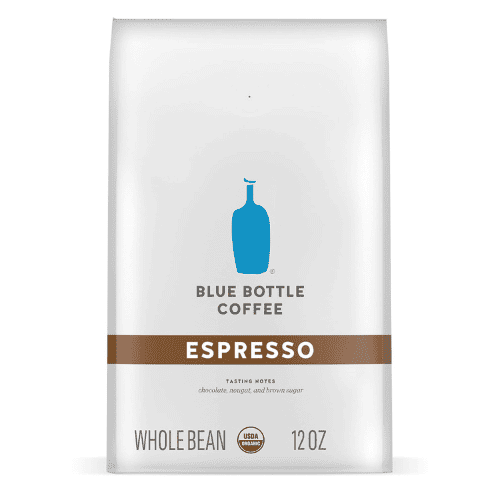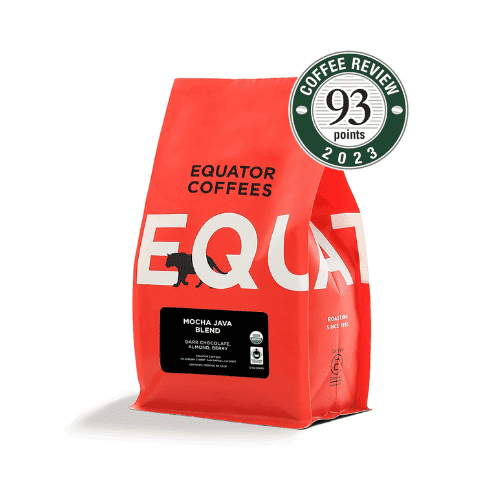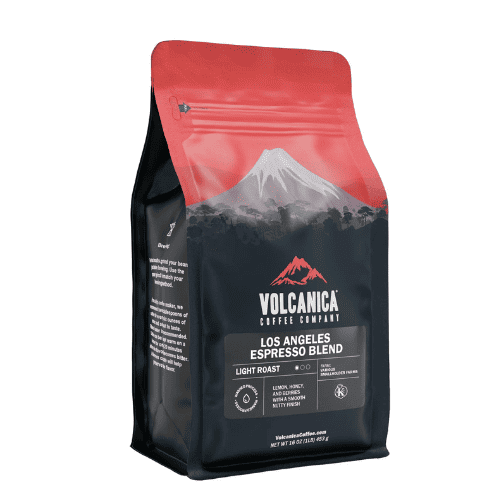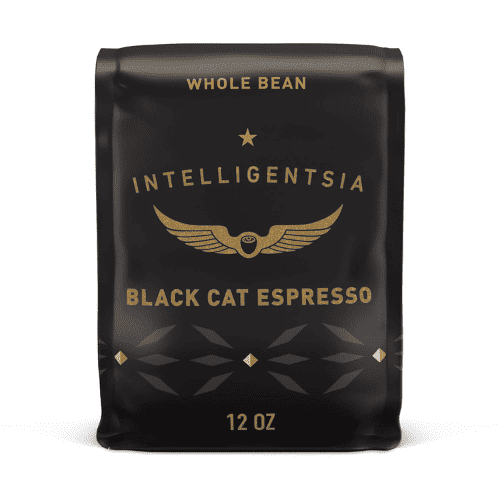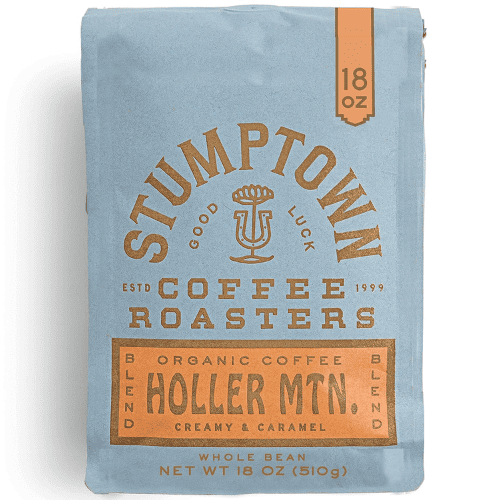What type of coffee makes the best espresso for espresso machines? Light, medium, or dark roasted coffee? The short answer is all three can make tasty espresso, but the gear you have can impact the quality of the shot. This is because some types of beans require precise brewing while others are more forgiving.
In this post you will learn the differences between espresso roasts and how to brew them to get the best tasting shots. We'll talk about brew ratios, temperatures, freshness, and give tips on what type of espresso beans you should buy depending on the espresso machine and grinder you have.
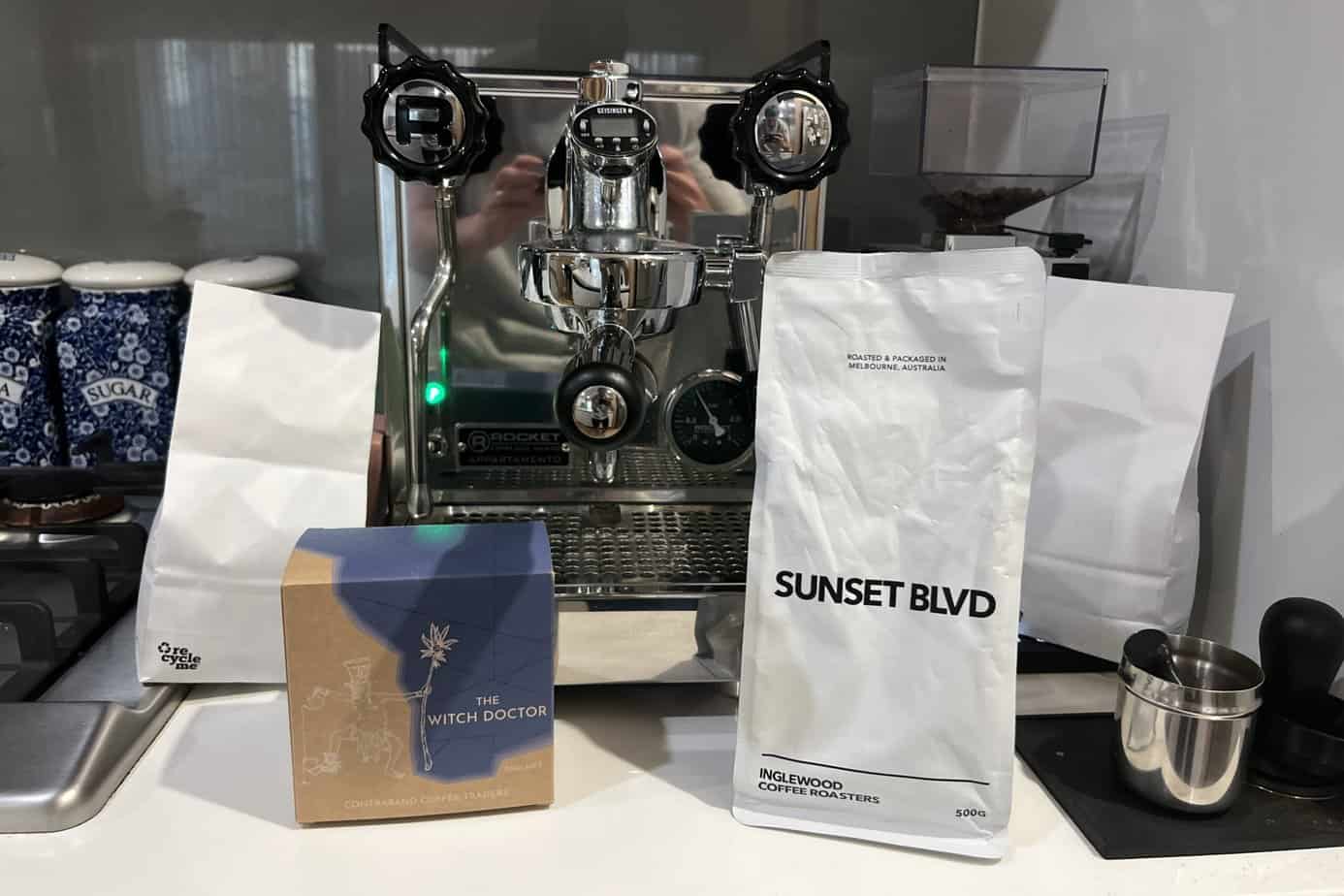
Espresso beans I bought from a local roaster at home.
What coffee beans to use for your espresso machine?
If you want a quick summary of this post, below are the key points:
- Start off with buying a medium or dark roasted coffee as they are more forgiving and make great tasting coffee with both entry level and high end coffee machines and grinders.
- Light roasted coffees require you to grind finer and brew at a higher temperature to get good tasting espresso that's not acidic. So if you don't have an espresso machine with a PID that can accurately set brew temperature or a good burr grinder that can grind fine, I would avoid lighter roasts. But if you do, get some, as you'll will get some unique and subtle flavors you can't get in darker roasted coffee.
- Light roasted coffee tends to taste better with higher brew ratios (more water passed through the espresso) to balance the acidity, whereas medium to dark can vary. We go into more detail later on.
- Light roasted coffee also works best with black or drinks with a small amount of milk, while medium or dark make great espresso and big milk drinks like cappuccinos and lattes.
- For the best tasting espresso I recommend buying beans from a local coffee roaster that roasts to order. Fresh beans are high in Co2 you want to let the beans rest 5-7 days from the roast date to get the best flavor. Fresh beans can reach peak flavor up to 30 days after roasting.
- Fresh coffee from a roaster can be expensive. So if you want to buy coffee online from Amazon or local supermarket that are cheaper, here are some key tips for better tasting ones:
i. Buy medium or darker roasted coffee from a well known bulk roaster.
ii. Examine the roast date on the package and always pick an earlier roast bag.
iii. And if you do want to buy an even cheaper bag of discount beans, I recommend going for a darker roast as they have better shelf life for their flavors.
Best espresso for espresso machines
If you're looking to buy some good beans for your espresso machine, below I've listed some good options. I've listed beans direct from roasters as well as quality batch roasts.
Espresso Beans | Roast Level | Flavors |
|---|---|---|
Dark | Chocolate, nougat, and brown sugar | |
Medium | Dark chocolate, almond, berry | |
Light | Honey, lemon, berries, with nutty finish | |
Medium | Dark chocolate, raw sugar, marshmallow | |
Medium | Caramel, hazelnut, and citrus zest |
Different espresso roast levels for coffee machines
When we talk about espresso the first thing to understand is that there are different types of roast levels. Roast levels are how long raw beans are roasted for to make espresso beans.
The type of roast not only dictates the flavor profile but also how the coffee interacts with your espresso machine. Generally, there are three different types of coffee roasts: light, medium, and dark.
Below I have outlined how they taste, best drinks to make with them, ideal brew ratio, and the type of espresso gear you need to get the best flavor from them. This will help you decide what type of espresso is right for you.
Light roast coffee
- Taste: Light roasts are known for their bright flavors. You'll get hints of fruit and florals and more delicate notes. However lighter roasts can be a bit challenging for espresso due to their complex flavor profiles.
- Drinks: I like drinking lighter roasted coffee black, being either espresso, lungo or americano as you can taste the unique flavors - milk tends cover these up. If you do use milk, make smaller milk espresso drinks like a magic or piccolo latte. They also work better with longer brew ratios to even up the acidity, such as 1 to 2 or 1 to 3 brew ratio. Brew ratios is how much water is passed through an espresso based - e.g. 20 grams of ground coffee in with 40 grams of espresso out is a 1 to 2 ratio.
- Gear: The get the best results from light roasted coffee, I recommend having a good burr grinder that can grind fine and and an espresso machine with a PID system that can set brew temperature at higher temps.
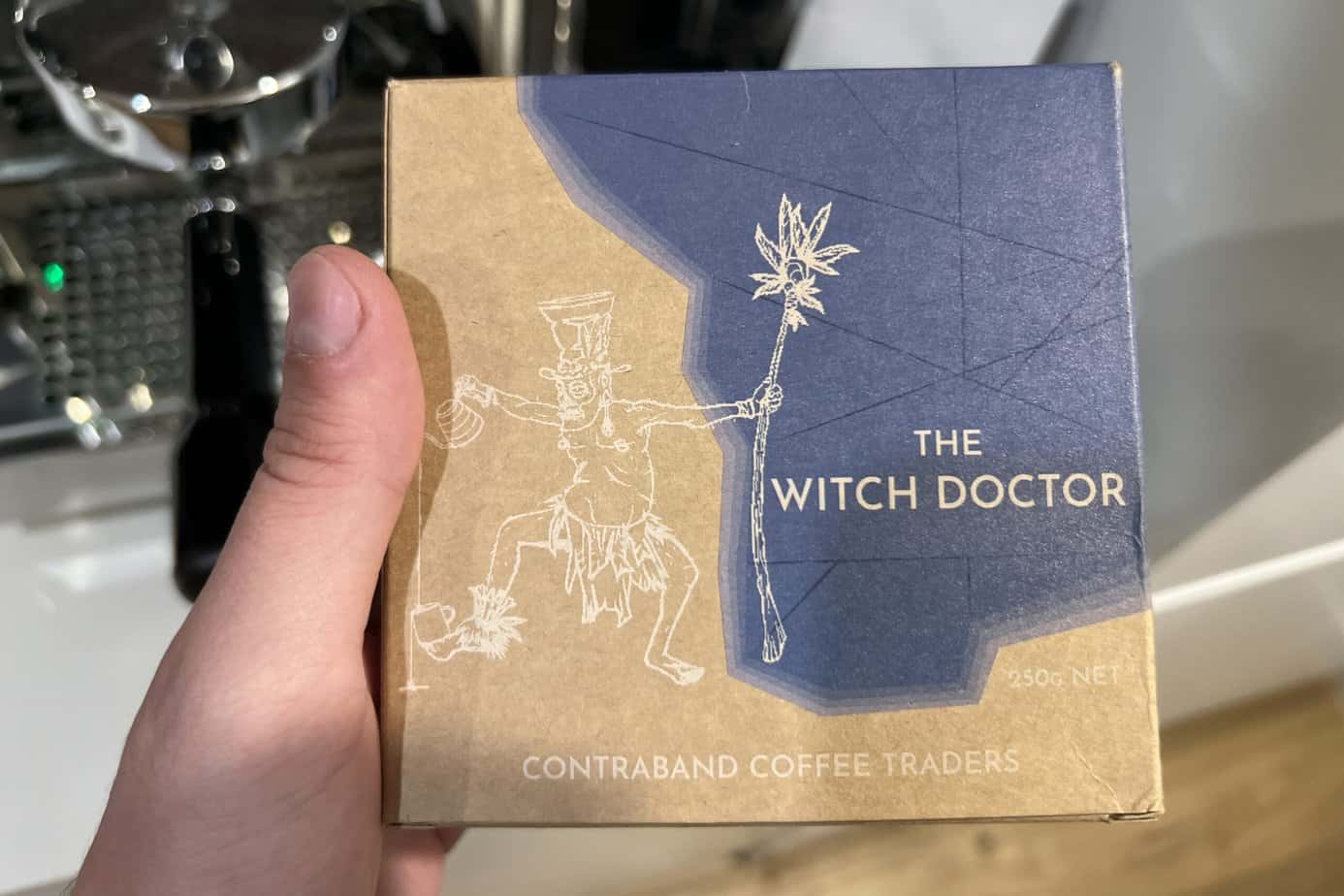
This is a light roasted coffee I have at home from a local roaster.
Medium roasted coffee
- Taste: Medium roasted coffee is the most popular blend and the roast I recommend people to start with. This is because they're balanced in flavor, with a perfect harmony of acidity and body. You will find them to have chocolate, brown sugar, or caramel notes, with some fruity after taste. They're Ideal for those who enjoy a strong but not overly bitter cup.
- Drinks: Medium roasted coffee work great for both straight espresso and milk based coffee. Be it a latte, americano or straight espresso. They're very versatile and work great with a big range of brew ratios.
- Gear: Medium roasts work great for a great range of espresso machines and grinders. This is because they are pretty forgiving to brew. They work great on both low to medium temperature extractions. So even if you don’t have an espresso machine with a PID system, you will find you will still get good tasting shots.
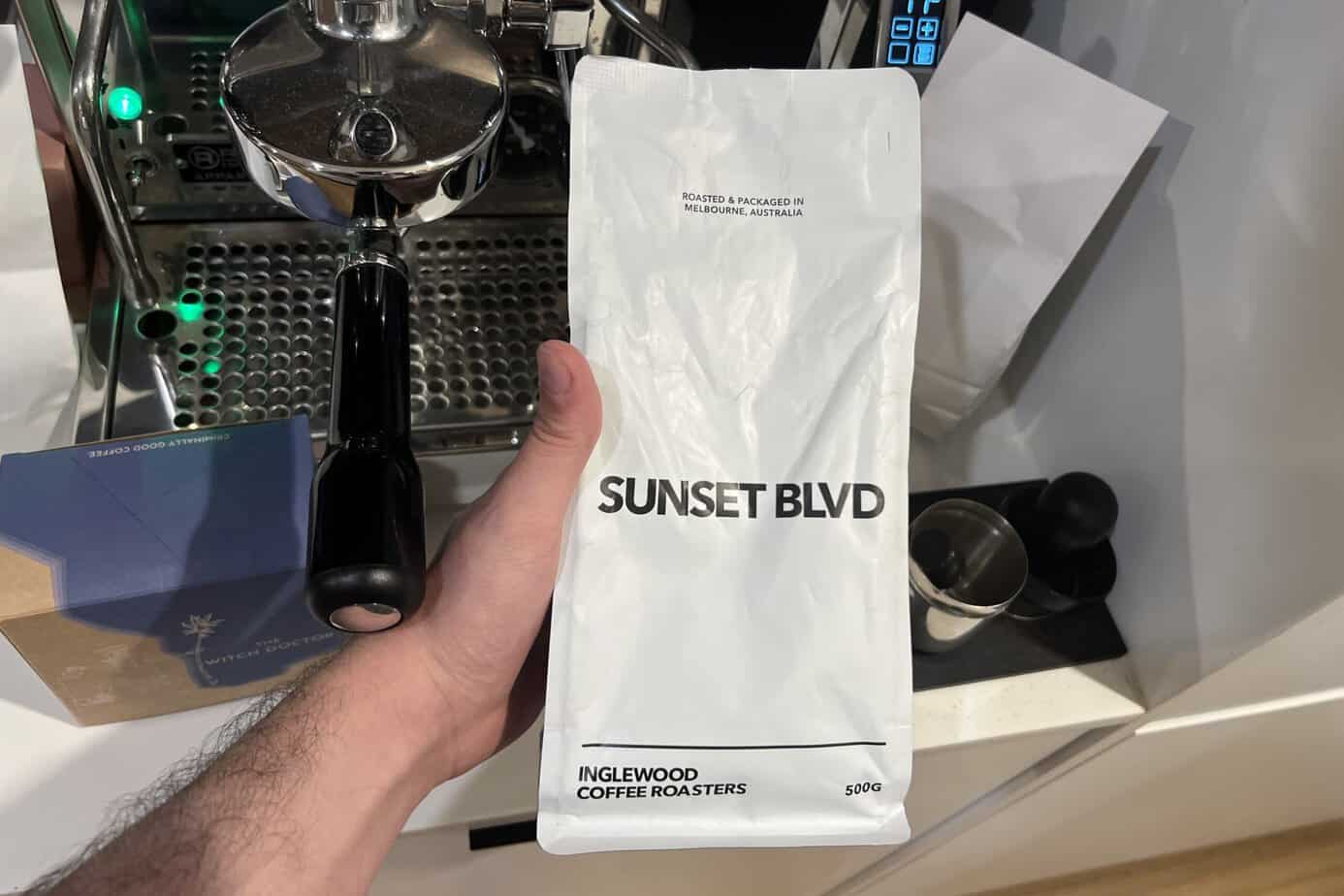
This is a medium roasted espresso bean with balance flavors and good for the majority of espresso machines.
Dark roasted coffee
- Taste: Dark roasted coffee are the "OG" coffee roast. This is the type of coffee you will find in Italy. They taste of deep chocolate and smoky notes. They are bold and intense in flavor, and can sometimes be quite bitter. They have very low acidity and have a big full body mouth feel, even syrupy at times.
- Drinks: Since dark roasted coffee is quite bold, they work best with milk-based drinks as the milk with sweeten them up and cut through the intensity. You can also drink them as straight espresso if you like earthy and bold flavors. You will not get fruity notes like you do with lighter or medium roasted coffee.
You want to brew dark roasted coffee at cooler temperatures, like 88 degrees celsius (190 fahrenheit). If brewed at higher temps, they get too bitter. And for brew ratios you want do to either 1 to 1 or 1 to 2. They don’t taste too good with larger ratios. - Gear: I recommend using an espresso machine that can brew at lower temperatures. You don't need a PID machine for this - just some level of control (for example a cooling flush on E61 espresso machines). However even if you can’t directly control temperature with your machine, dark roasts are pretty easy to brew as their as their Flavors are bold - especially if you drink it with milk.
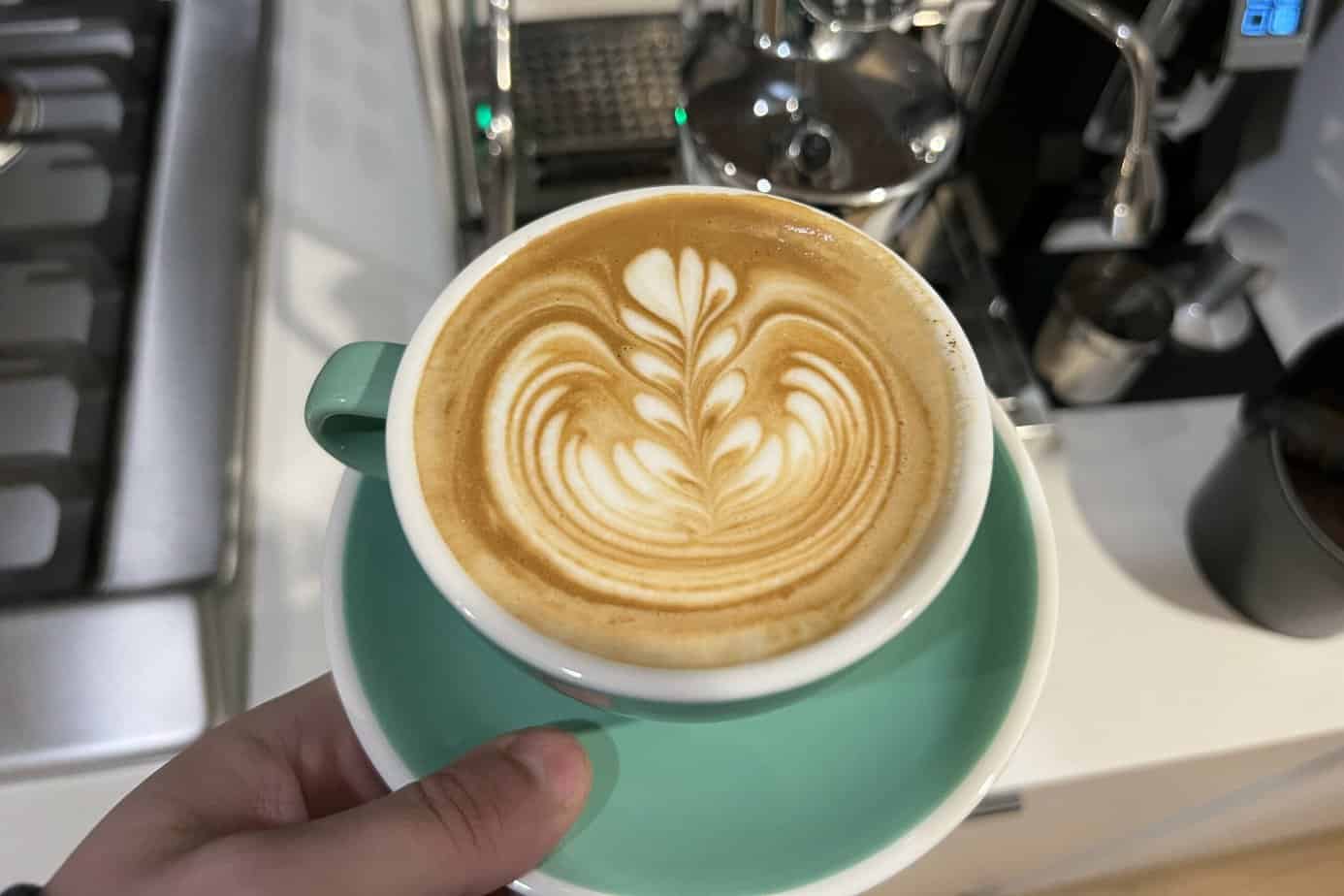
Medium and dark roasted coffee work great with lattes.
Factors that impact taste of coffee beans in espresso machines
The next thing to understand when buying beans for your espresso machine is the factors that impact the taste of your coffee. The type of espresso machine or grinder you have may be better suited to a certain type of coffee roast to get the best taste.
Below I have outlined the main factors you need to consider to make good tasting espresso for different types of coffee: temperature, freshness of the bean, and the gear you use.
Temperature for different roast levels
The three types of coffee roasts (light, medium, and dark) are best extracted at different temperatures. Lighter roasts are better are higher temperatures, while dark at lower, and medium in between. The table below outlines what's the ideal temperature range for these coffee roast. So if your espresso machine can't hit the below temperatures or is limited in changing temps, you will want to get the type of coffee roast that it is set to brew to.
Roast Level | Ideal Brew Temperatures (Celsius) |
|---|---|
Light Roast | 94 - 96 (201 - 205 fahrenheit) |
Medium Roast | 90 - 94 (194- 201 fahrenheit) |
Dark Roast | 88 - 90 (190 - 194 fahrenheit) |
Fresh whole bean vs pre-ground coffee for your espresso machine
You should always buy fresh whole beans to get the best tasting coffee. Pre-ground may taste good on the first day you get it, however shortly after you will find their taste will deteriorate. The main reasons why whole beans are better than pre-ground are:
- Freshness: Whole beans retain freshness longer as the protective outer layer helps preserve flavors and aromas until grinding. Pre-ground beans begin to lose freshness quickly due to increased surface area exposed to air, leading to a faster decline in flavor.
- Customization: Whole beans allow for greater control over grind size. What you will find is as the beans age, you will need to change the grind size to get the same brew ratio and flow out of the espresso. This allows you to dial in your shot to be perfect.
Whereas you can't customize pre-grounds beans. They also may not be ground fine enough from the get go, and if this is the case, then you will never be able to pull a perfect shot. A pressurised portafilter may help great crema, but the taste won’t be as good. - Storage: You can store whole beans in air tight containers or freeze them to retain their freshness for a long period of time if you like to swap between beans. Pre-ground coffee can't do this.
What espresso beans to buy based on your espresso machine and grinder?
The type of espresso machine and grinder you have will impact on the type of coffee roast you should buy to make the best tasting coffee. In general, to make great tasting espresso you need to be able to control the following: the coffee grind size, brew temperature, and volumetric extraction.
Not all coffee gear can control every part of the brew process to get the most of every type of espresso machine. So you should consider the type of gear you have when buying coffee beans. Light roasted coffee is the most temperamental, whereas medium and darker roasted coffee are forgiving. Below is my recommended gear to have to buy each type of coffee roast.
- Light roasted coffee: You want an espresso machine with a PID system, ideally with a dual boiler to independently control the brew temperature or a thermojet or coil system for exact control of brew temperature at the group head. Otherwise, you want to have a tool that can measure the temperature at the group like the group head thermomotor I have on my espresso machine below.
You also want a good quality burr grinder for espresso. You have to grind light roasts finer to get more flavor out of them. - Medium and dark roasted coffee: Both of these types of roasts are more forgiving as they have a bigger range of temperature to get the best results and they don't have to be ground as fine as light roasts. You just want a good quality espresso machine and grinder.
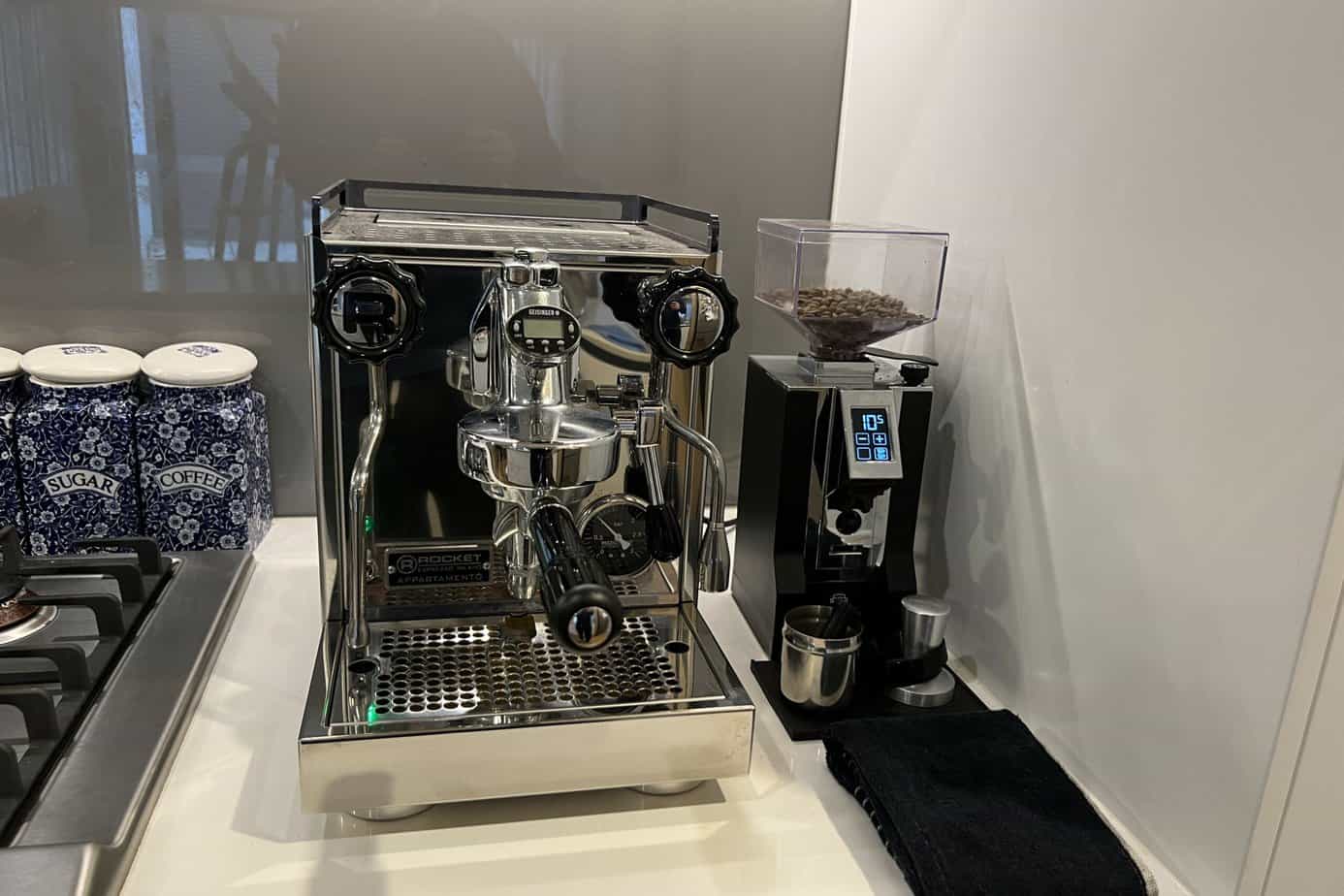
My coffee station. You can see I have a high quality grinder and a tool that can measure brew temp.
What type of espresso is best for super-automatic espresso machines?
If you have a super-automatic espresso machine, I recommend avoiding dark roasted coffee as they tend to have more oils than medium and light roasts. These oils can are harder to clean in super-automatics compared to semi-automatic systems.
Best espresso beans for different coffee drinks
Below I have outlined what the best types of coffee roasts are for certain drinks. Please note this is my personal recommendation. There is nothing stopping you from using different roasts for different drinks. I just find from my experience as a barista the flavor profiles compliment different beverages. You will find that medium roasts are a good all rounder.
Roast Level | Recommended Coffee |
|---|---|
Light Roast | Espresso, lungo, americano/long black, magic, piccolo latte, cortado, macchiato |
Medium Roast | Espresso, lungo, americano/long black, magic, piccolo latte, cortado, latte, cappuccino, flat white, macchiato |
Dark Roast | Espresso, lungo, magic, piccolo latte, cortado, latte, cappuccino, flat white, macchiato |
Best espresso beans for milk-based coffee: Flat White, Latte, Cappuccino, Mocha, Macchiato, Piccolo
I recommend drinking medium or dark roasted coffee if you enjoy your coffee with milk. This is because they tend to have flavor profiles that complement it like chocolate, caramel and sugars. Dark roasted coffee goes well with milk as it is very intense and bold in flavor, so the sugar in the milk helps balance out the flavor. If you like drinking milk based drinks, I recommend trying Intelligentsia below.
Medium roasted coffee
This blend from Intelligentsia is great for milk based drinks as it has hints of dark chocolate, raw sugar, and marshmallow that work great with lattes, cappuccinos and other milk drinks.
Best coffee beans for black coffee: Ristretto, Espresso, Long Black
If you like coffee without milk, then I recommend trying a light or medium roasted coffee. When you drink your coffee black you will be able to pick up the unique characteristics of different coffee beans, and light and medium tend to have these interesting flavors to pick up. For example, you can try the Volcanica below.
Light roasted espresso beans
The best thing about light roasted espresso is that you can taste unique falvors that only come out in black coffee. This one from Volcanica has hints of honey, lemon, berries, and a nutty finish.
Conclusion
And there we have it! I hope you know have a good idea of what type of espresso will work best for your espresso machine and taste preferences. At the end of the day, I recommend trying all three different roasts. This will help you decide what type of coffee works best for you and the gear you have. If you have any questions feel free to leave a comment below.

